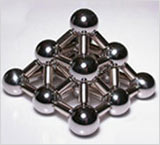Home » Types of Magnets » Rare Earth Magnets » Neodymium Magnet
Neodymium Magnet
| Properties | Features | Magnetizing and Handling |
| Characterstics | Applications | Articles |
Neodymium permanent magnets are strong magnets which consist of neodymium, iron, boron and a few transition metals. These magnets have metallic appearance and are found in simple shapes like rings, blocks and discs. The neodymium rare earth magnets are strong magnetically and are brittle in nature hence they must be handled with care. Since it is amenable to chipping and cracking it can be only be abrasively ground and that too along with the coolant. Due to their low cost they have successfully replaced heat resistant and marginally weaker magnets in various industrial applications.
-
The neodymium magnets are brittle in nature and less heat resistant.Machining
Neodymium is a brittle magnet hence conventional machining can harm the magnet. By using coolant the magnet can be abrasively ground. The coolant reduces the risk of heat manufacturing and also minimizes heat fracturing and the risk of fires caused by oxidized grinding dust.
- Their resistance to demagnetization is high.
- Neodymium rare earth magnets are corrosive in nature hence they are coated for long term maximum energy output.
- For working in ambient temperature they are good.
- They have good resistant to demagnetization
- In ambient temperature,they are good
- Neodymium rare earth is prone to corrosion hence should be coated for long term maximum energy output
- Low working temperature for heat applications
 Since neodymium rare earth magnets are brittle hence it is necessary that they are handled with utmost care. Any injury to magnet may spoil it. While handling be careful that the fingers do not come in between the attracting magnets as it might cause injury to your fingers.
Since neodymium rare earth magnets are brittle hence it is necessary that they are handled with utmost care. Any injury to magnet may spoil it. While handling be careful that the fingers do not come in between the attracting magnets as it might cause injury to your fingers.If magnet is allowed to jump at an attracting object it can chip hence these jumping of the magnet should not be allowed. For good result it will be better to magnetize the material after assembly.
Characterstics
| Thermal Characteristics | ||||
| Neodymium Material Type | Temp. Coefficient (aBr) | Maximum Operating Temp | Curie Temp | Thermal Conductivity |
| %/°C | ºC (ºF) | ºC (ºF) | kcal/m-h-°C | |
| N | -0.12 | 80ºC (176ºF) | 310ºC (590ºF) | 7.7 |
| NM | -0.12 | 100ºC (212ºF) | 340ºC (644ºF) | 7.7 |
| NH | -0.11 | 120ºC (248ºF) | 340ºC (644ºF) | 7.7 |
| NSH | -0.10 | 150ºC (302ºF) | 340ºC (644ºF) | 7.7 |
| NUH | -0.10 | 180ºC (356ºF) | 350ºC (662ºF) | 7.7 |
| NEH | -0.10 | 200ºC (392ºF) | 350ºC (662ºF) | 7.7 |
| NZ | -0.10 | 200ºC (392ºF) | 350ºC (662ºF) | 7.7 |
| Physical and Mechanical Characteristics | |
| Density | 7.4-7.5 g/cm3 |
| Compression Strength | 110 kg/mm2 |
| Bending Strength | 25 kg/mm2 |
| Vickers Hardness (Hv) | 500 - 600 |
| Tensile Strength | 7.5kg/mm2 |
| Young’s Modulus | 1.7 x 104 kg/mm2 |
| Recoil Permeability | 1.05 µrec |
| Electrical Resistance (R) | 160 µ-ohm-cm |
| Thermal Expansion Coefficient (0 to 100°C) parallel to magnetization direction | 5.2×10–6 /°C |
| Thermal Expansion Coefficient (0 to 100°C) perpendicular to magnetization direction | –0.8×10–6 /°C |
Applications
The applications of the neodymium rare earth magnets are:
- They are used for stabilization and angular head motors in
- They are also applicable in various earphones and headphones.
- Neodymium magnets have usage in various other industrial products like:
- Magnetic separators.
- Linear actuators.
- Microphone assemblies.
- DC motors.
- Printers.
- Speakers.
- Food Processing Industries etc.
| Articles :: Neodymium In Hydrogen Atmosphere |
